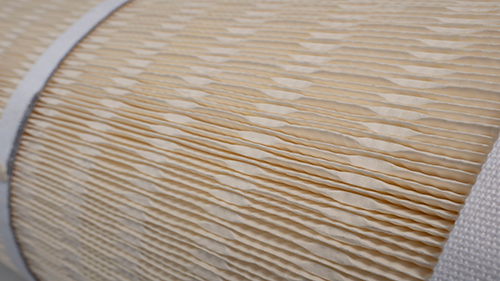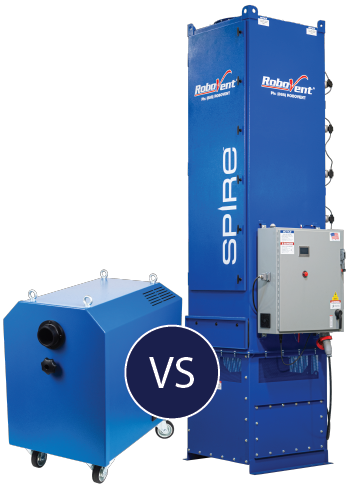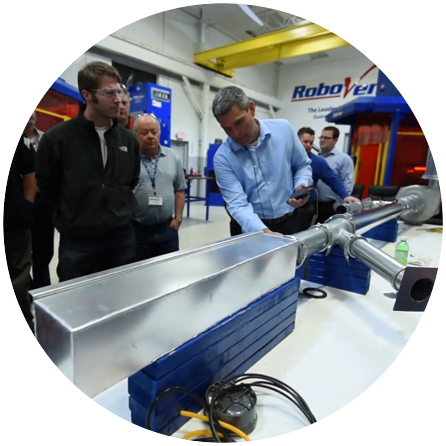Understanding Cartridge Dust Collector Pricing
If you’re in the market for a cartridge-style industrial dust collector, you’re probably in the process of comparing multiple bids. But to make an educated decision, you have to understand how to make an apples-to-apples comparison between different dust collector models and bids. A collector that is not properly sized to your application could leave your facility out of compliance with OSHA regulations and put employees at risk.
The Big Three of Dust Collector Pricing: CFM, Static Pressure and Air-to-Cloth Ratio
The cost of a cartridge-style dust collector is dependent on three important variables: airflow (cubic feet per minute, or CFM), static pressure and air-to-cloth ratio. When comparing bids, make sure you are looking at models that are comparable on all three elements. If the low-price bid has significantly lower CFM and/or static pressure or significantly higher air-to-cloth ratio, it may mean that the vendor is underbidding for the demands of your project.
What is dust collector CFM?
CFM is a measure of the air flow rate, or the volume of air the dust collector can move within a particular timeframe. This is directly related to the horsepower (HP) of the motor. In general (given the same blower wheel), the higher the HP of the motor, the more air the dust collector can move per minute.
Your CFM requirements will depend on the type and volume of dust that your operations produce, whether you are using source capture or ambient filtration, and the volume and velocity of air you need to move to effectively capture particulate. An air quality engineer will calculate your CFM requirements based on:
- The volume of air needed to capture particulate from an operation.
- The size of openings/areas that need to be protected from air contaminants.
- The velocities needed to keep fugitive dust/particulates from leaving a process and migrating to other parts of the plant.
What is dust collector static pressure?
Static pressure within the dust collection system is a result of natural air resistance, friction within the ductwork and dust collector itself, and the movement of air through the filter media. It is commonly measured in inches of water column pressure, or WC. Differential pressure, or pressure drop, is the difference in pressure between the “clean” and “dirty” sides of the filter; as filters load, you will see higher pressure drop and greater static pressure within the system.
SP is intrinsically related to CFM. Your dust collector’s CFM rating is for a specific amount of resistance. As resistance within the dust collection system rises (for example, as filters become loaded), CFM will decline. If your system SP is not sized to account for this your duct collector will no longer be moving the correct amount of air to protect your employees and plant.
This also causes hazards in your ductwork as transportation velocities fall due to lack of airflow. Minimum Transport Velocity is defined as the air speed that must be maintained in a duct to ensure that particulate does not drop out of the airstream. In severe cases, airflow may be reduced to next to nothing in the ductwork. The added weight of particulate within the ductwork may create structure issues and, in the worst cases, may even cause ductwork to collapse.
SP is also related to HP. The horsepower required to generate a specific CFM is correlated with SP in a series of equations known as the fan laws. The more static pressure you have in your system, the more horsepower will be required to overcome the pressure and achieve the desired air velocity. The relationship between HP and SP is cubic rather than linear. The best way to understand this is to examine the fan curve for your dust collection system.
What this means is that a CFM rating for a dust collector can only be understood in relation to the static pressure the system is rated for. This tells you how much power the system has to generate airflow against resistance. When comparing two dust collectors rated for 1000 CFM, the one with the higher SP rating has greater potential energy. That means it will perform better as filters become more loaded or for systems with extra-long ductwork.
What is dust collector air-to-cloth ratio?
Air-to-cloth ratio (sometimes called filtration velocity) is the ratio of air (in CFM) to the filter media (measured in square feet). You can calculate air-to-cloth ratio by dividing the CFM of your dust collector by the total area of filter media it contains. For example:
- A dust collector with 1,000 CFM and 2,000 square feet of filter media has an air-to-cloth ratio of 0.5:1.
- A dust collector with 2,000 CFM and 2,000 square feet of filter media has an air-to-cloth ratio of 1:1.
- A dust collector with airflow of 4,000 CFM and 2,000 square feet of filter media has an air-to-cloth ratio of 2:1.
Your air-to-cloth ratio requirements will depend on the volume and size of particulates you are collecting. Applications that produce a lot of particulate, such as robotic welding or laser cutting, generally require a lower air-to-cloth ratio than applications that produce less particulate. In other words, applications with heavier loading require more filter media for each unit of air the dust collector is moving. Read more: Air to Cloth Ratio—What Is It, and Why Does It Matter?
Other Factors Impacting Dust Collection System Cost
While CFM, static pressure (or HP) and air-to-cloth ratio are the biggest items driving dust collector cost, there are a few other line items you may want to check when comparing your bids.
-
- Motor type: Does the dust collector have a fixed speed or variable frequency drive (VFD) motor? A VFD motor can ramp the fan speed up and down depending on the resistance in the system. A fixed speed motor is cheaper up front, but VFD can save energy costs over time.
- Filter media selection: Cheap, inferior filter media may cost less up front, but it will need to be changed more often, driving up maintenance costs over time. Failed filters can also result in dust escaping past the filter through pinholes and tears, putting your facility out of compliance with clean air regulations.
- Ductwork: If your quote also includes ductwork, look at the size and material for the ductwork quoted. Make sure it is adequate for your CFM needs and type and volume of dust. Abrasive dusts will require more durable ductwork.
- Installation costs: Are all installation costs included in the bid? Make sure there won’t be any surprises once the bid is accepted.
- Dust collector features: See what features are included with each dust collector. What kind of control system does it have? Is the filter pulsing mechanism adequate for the volume and type of dust you produce? Does it include safety features such as an internal fire suppression system, particulate monitoring or a spark arrestor? Make sure the feature package meets your needs.
What Happens if Your Dust Collector is Undersized?
Selecting an undersized dust collector will save capital expenses up front but will cost more in the long run through a shorter service life, higher maintenance and consumable costs, and poor performance. It may also put your facility out of compliance with OSHA or EPA regulations because it will not adequately control dust and emissions and protect employees in the plant.
Sometimes, companies underbid a dust collector based on CFM, static pressure, air-to-cloth ratio, or all three. All of these scenarios will cause problems.
Underbidding Based on CFM and Static Pressure
Remember, CFM means nothing without also knowing the static pressure the system is rated for. You need to make sure you will have adequate airflow under all operating conditions, including conditions at the end of your filter life.
- First, look at the CFM rating. If one company is bidding CFM substantially lower or higher than others, ask why. Make sure you understand how the CFM requirements were calculated.
- Then, look at the static pressure rating and HP of the motor. Many companies bid based on static pressure of 10 to 12 WC. This may be adequate when filters are new and pristine but may not be enough power to maintain CFM when filters are loaded. 15 to 18 WC is more appropriate for many applications.
- Looking at the fan curve for the system can help you understand whether the system has been adequately designed for your application.
Inadequate CFM or static pressure will result in:
- Poor air velocity in the ductwork.
- Heavier dust falling out of the airstream in the ductwork.
- System failure when filters are heavily loaded.
- Failure to adequately remove process dust, putting employee health and safety at risk.
Underbidding Based on Air-to-Cloth Ratio
The other common way dust collectors are underbid is by under-sizing the filter media. If you don’t have enough filter media for your application (your air-to-cloth ratio is too high), you will see a number of problems with dust collector performance. These include:
- Reduced filter life: When you don’t have enough filter media, it may create higher can velocities within the dust collector (due to the smaller collector housing). As a result, dust is driven deeper into the media, making it harder to pulse off. This results in faster filter loading and more frequent filter changes.
- Increased maintenance costs: Filters may need to be changed up to four times as often, significantly impacting consumable costs, labor costs and downtime.
- Increased energy costs: Operating with loaded filters raises static resistance, requiring more horsepower to maintain CFM. If you are using a Variable Frequency Drive (VFD) motor, it will be operating at maximum capacity much of the time, erasing potential energy savings from the VFD.
- Poor IAQ: Indoor air quality will suffer if filters are allowed to operate loaded because the dust collector will not be able to remove the process dust as required. This may put you out of compliance with OSHA regulations and put employee health and safety at risk.
How RoboVent Sizes Dust Collectors
We use a science-based approach to sizing dust collectors, so you are guaranteed optimal performance and service life.
- We size our dust collectors with adequate HP to cover both internal and external system static pressure with enough overage to compensate for additional static demands from seasoning of the filters. That means
that the system will continue to perform well even with filters loaded.
- VFD is standard for most of our dust collectors. A VFD motor saves energy when filters are new and ensures that you will have adequate HP to handle the additional static pressure when filters are loaded. With VFD, the dust collector can respond to actual operating conditions, so CFM remains static and does not drop as filters load.
- We ensure that the dust collector has proper air-to-cloth ratio for the application and usage demands so that filters will not become prematurely loaded.
- We’ll work with you to select the right filter media for optimal filter life and performance.
If you are comparing bids and you see big differences in CFM, static pressure or air-to-cloth ratio, ask us about it! We will be happy to walk you through our engineering design decisions and help you make an “apples-to-apples” comparison with competing bids.
Contact Us With Your Questions!
SUBSCRIBE TO
BLOG UPDATES






 that the system will continue to perform well even with filters loaded.
that the system will continue to perform well even with filters loaded.






